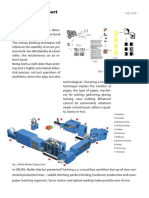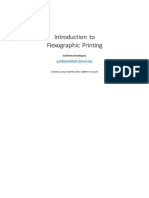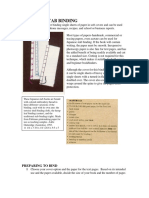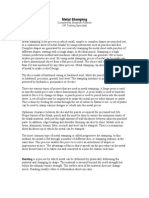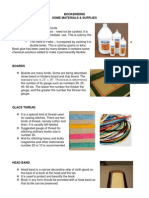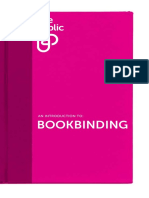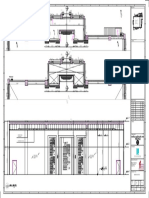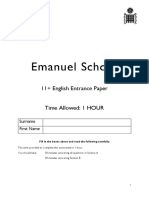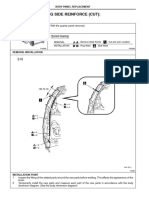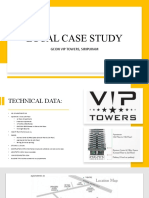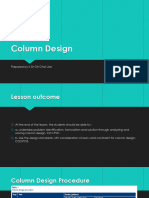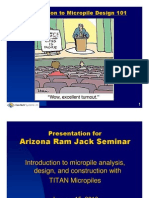UNIT 12
POSTPRESS PROCESSING 2
Cropping (cutting), glue binding, creasing, folding, hole punching, enveloping and
perforating are examples of common off press processes. When printed sheets intended for
books are off press processed, the sheets are bound or glued into blocks, cut to the correct
format and then attached to a cover. Products with smaller formats such as brochures,
periodicals, etc., are often stapled together with a cover. Printed products with more than two
pages are generally folded. If the product has eight or more pages, it is usually also stapled
or bound. Generally, all printed products need to be cropped during off press processing.
Folding
Folding is a technique used to create smaller individual pages from the large printed
sheets. There are two main folding techniques: parallel folding and right-angled folding.
Parallel folding, as the name indicates, means that all the folds run parallel to each other.
Parallel folding is used when the printed product being processed does not need to be
bound. Right-angled folding, on the other hand, means that each new fold is done at a 90-
degree angle to the previous one, and is used for products that are going to be bound. There
are also combinations of parallel and right-angled folding.
Creasing
When a paper's weight exceeds 80 lbs, it can be very difficult to fold. To avoid
unattractive folds, heavy paper is usually creased before it's folded. Creasing creates a kind
of "hinge" that facilitates a clean fold. Paper is often creased with the help of a thin steel
"ruler" pressed along the fold lines. The paper's resistance to folding is reduced along the
resultant crease. Creasing is frequently used for processing cardboard.
Covers used in glue binding, for example, are usually creased. When glue binding with a
thick cover, you will get the best results with a "four-crease" techniques. A four-crease is
literally a total of four distinct creases in the cover: one on either side of the spine, one a few
millimeters from the spine on the front cover, and one a corresponding distance from the
spine on the back cover. The creases in the covers prevent damage to the folds and allow the
product to be opened with ease.
Binding
Binding is the joining of a number of individual printed sheets into a single entity, be it a
book, brochure, etc. The most common binding methods are metal stitching, glue binding,
thread stitching and spiral binding. In metal stitching and spiral binding, the cover is attached
during the actual binding process. In thread stitching and glue binding there are two
ways of attaching, or hanging, the cover. In the first version (for soft covers), the
cover is glued to the spine of the bound material. In the second (for hard covers), the
first and last pages of the material, called the endpapers, are glued to the insides of
the covers. End papers are usually colored or patterned papers.
Metal stitching
Stapling papers together with a standard desk stapler is a kind of metal stitching that we've all
done. In terms of professional binding, there are two main types of metal stitching. One is
�block stitching, in which metal stitches (staples) are placed along one edge or on one corner
of the pages, much like the desktop stapling we've used to. The second is known as saddle
stitching, which places metal stitches in the spine of the material.
Thread stitching
Thread stitching is the traditional bookbinding method. Folded sheets are placed in sheet
order, but instead of being glues the spine is sewn together. As with glue-bound soft cover
books, the book block is glued to the cover. However, the spine is not ground - if it was, the
thread sewing would disappear. Instead, after the cover is in place along the spine, the book
is cropped along the three remaining sides. As with other methods, it is important that the
fiber direction run parallel to the spine in order to ensure a strong and aesthetically pleasing
product.
Cropping
Cropping simply means cutting the paper down to the desired size with some kind of
blade. This can be done manually with a special cutting machine or simultaneously with
another step in the off press processing cycle.
Most printed products are cropped. In sheet-fed print production, it can be necessary to
crop a product up to three different times during the production cycle. First, the paper might
require cropping in order to fit the format of the printing press. After they are printed, the
sheets may have to be cropped again to fit the format of the off press processing machine(s).
Finally, the product must be cropped after it is folded and bound to ensure that its edges
are even and smooth.
In the most common binding methods, (metal stitching or glue binding). Cropping is
usually the last step of the process. Generally, a three-sided trimmer crops the printed
product on the head, tail and fore edge. This final cropping is necessary for several reasons.
Multiple pages imposed on the same printing sheet are still attached to each other after
they've been folded, either at the head or the tail (this applies if you have right-angled
folded sheets with eight or more pages). In addition, the creep requires that the bundle be cut
along the fore edge.
The blades used in the cropping machines are sensitive and must be sharpened often.
Varnished and laminated paper can damage or blunt the blade. A damaged blade can create a
striped appearance along the cropped surface of the printed product.
Lamination
Lamination is the process of coating a printed page with a protective plastic foil.
Lamination increases protection against dirt, humidity and wear and tear, and is also done for
aesthetic reasons. There are a variety of different types of laminates, including glossy, matte,
embossed and textured. Laminates are commonly applied to the covers of printed products.
A special laminating machine is required for this process, and coated or glazed paper will
give the best quality output. Laminated sheets can be creased and folded.
Varnishing
Varnishing is a technique used to add a glossy surface to a printed product. Unlike
lamination, it does not provide noticeable protection against dirt and wear and tear, and is
primarily an aesthetic procedure. Varnish is often applied to the print in the offset press via a
regular inking unit or a special unit just for varnish. Coated paper grades will give the best
results. UV-varnishing is another common method in which varnish is applied to the print
with a special UV-varnishing machine. Because the varnish is cured with ultra-violet light, it
�can be applied in a thicker layer, and thus provide a higher quality finish. Varnished sheets
should be creased before they are folded to avoid the formation of cracks on the varnish-
hard surface.
Varnish can be applied selectively to certain parts of the image - over images and logo-
types, for example. This partial-varnishing method is used for aesthetic effect as well as to
help prevent areas with dense ink coverage from smearing.
Punching
Paper is punched during off press processing so it can be put into binders. The
international standard, known as ISO 838, is the standard outside of North America. Within
North America, the hole spacing standards are 2 ¾ " cc for 2-hole and 4 ¼ “ cc for 3-hole
punching ("cc" stands for center-to-center, and means that the holes are spaced from the center
of the hole regardless of its size). Generally, special drills are used to punch paper when this is
done during off press processing, but you may also be able to purchase pre- punched paper from
your paper manufacturer.
Die-cutting
If you want your printed product to have a shape other than a rectangle, you can have it
die-cut.
A punch die is created in the shape you want for your product. The die is then pressed
against the printed paper and cuts it to the desired shape. The cost for producing a unique punch
die is relatively high for printed products in small editions, but it can be used for reprints..
Perforating
Perforations are basically used to create a tearing reference. By punching a dotted line in a
page, you make it easier to tear off a particular section of that page - a reply card, for
example. Perforation is usually done in a letterpress with a special perforation blade, which is
pressed into the paper, creating a series of tiny slits. Perforation can also be done in a special
punching machine.
Foiling
A printing form (a stamp) is heated and prints the material using a foil. The result is a
depression in the material in the same color as the foil. The color is usually gold or silver
although other colors are available.









